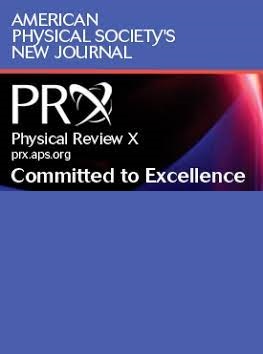Heralded Entanglement of On-Demand Spin-Wave Solid-State Quantum Memories for Multiplexed Quantum Network Links
IF 15.7
1区 物理与天体物理
Q1 PHYSICS, MULTIDISCIPLINARY
引用次数: 0
Abstract
The ability to distribute heralded entanglement between distant matter nodes is a primitive for the implementation of large-scale quantum networks. Some of the most crucial requirements for future applications include high heralding rates at telecom wavelengths, multiplexed operation, and on-demand retrieval of stored excitations for synchronization of separate quantum links. Despite tremendous progress in various physical systems, the demonstration of telecom-heralded entanglement between quantum nodes featuring both multiplexed operation and on-demand retrieval remains elusive. In this work, we combine narrow band parametric photon-pair sources and solid-state quantum memories based on rare-earth doped crystals to demonstrate telecom-heralded entanglement between spatially separated spin-wave quantum memories with fully adjustable recall time and temporal multiplexing of 15 modes. In a first experiment, the storage in the spin state is conditioned on the entanglement heralding. We take advantage of the control over readout pulse phase to achieve feedforward conditional phase shifts on the stored photons depending on which heralding detector clicked. We exploit this effect to double the entanglement heralding rate for a given quantum state up to 510counts/s, with an associated detection rate of多路量子网络链路中按需自旋波固态量子存储器的预示纠缠
在遥远的物质节点之间分布预示纠缠的能力是实现大规模量子网络的基本条件。未来应用的一些最关键的要求包括电信波长的高预告率,多路复用操作,以及为同步单独的量子链路而按需检索存储的激发。尽管在各种物理系统中取得了巨大的进步,但电信预示的量子节点之间的纠缠,具有多路复用操作和按需检索的演示仍然难以捉摸。在这项工作中,我们结合了窄带参数光子对源和基于稀土掺杂晶体的固态量子存储器,以证明具有完全可调回忆时间和15种模式的时间复用的空间分离自旋波量子存储器之间的电信预示纠缠。在第一个实验中,自旋态的存储以纠缠预示为条件。我们利用对读出脉冲相位的控制来实现存储光子的前馈条件相移,这取决于哪个预示探测器点击。我们利用这一效应将给定量子态的纠缠预示率提高了一倍,达到510counts/s,相关检测率为0.32 counts/s,并测量了高达6个标准差的正并发性。在第二个实验中,我们通过实现死区时间为100 μs的无条件存储方案来模拟远程链路的通信时间。我们利用时间复用将纠缠率提高到单模存储的15倍,达到每个预警检测器22个计数/秒的值。这些结果使我们的架构成为实现可扩展的高速量子网络链路的主要候选者。
本文章由计算机程序翻译,如有差异,请以英文原文为准。
求助全文
约1分钟内获得全文
求助全文
来源期刊

Physical Review X
PHYSICS, MULTIDISCIPLINARY-
CiteScore
24.60
自引率
1.60%
发文量
197
审稿时长
3 months
期刊介绍:
Physical Review X (PRX) stands as an exclusively online, fully open-access journal, emphasizing innovation, quality, and enduring impact in the scientific content it disseminates. Devoted to showcasing a curated selection of papers from pure, applied, and interdisciplinary physics, PRX aims to feature work with the potential to shape current and future research while leaving a lasting and profound impact in their respective fields. Encompassing the entire spectrum of physics subject areas, PRX places a special focus on groundbreaking interdisciplinary research with broad-reaching influence.
 求助内容:
求助内容: 应助结果提醒方式:
应助结果提醒方式:


